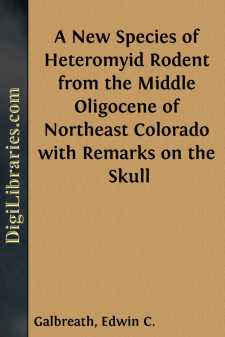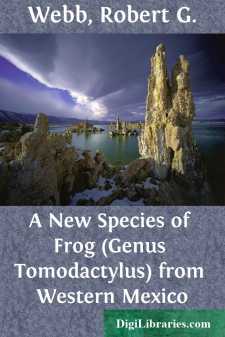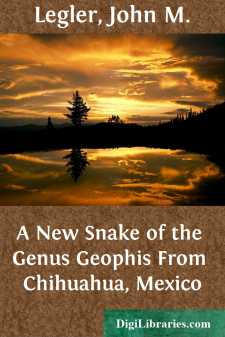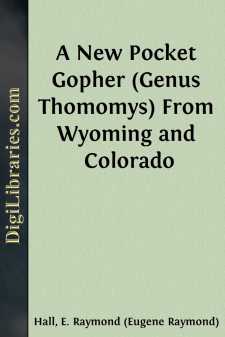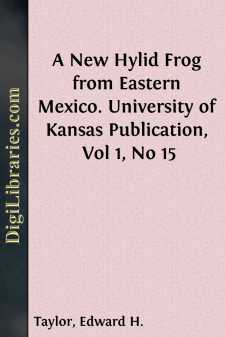Fiction
- Action & Adventure 180
- Biographical 15
- Christian 59
- Classics
- Coming of Age 5
- Contemporary Women 3
- Erotica 8
- Espionage/Intrigue 12
- Fairy Tales, Folklore & Mythology 236
- Family Life 169
- Fantasy 117
- Gay 1
- General 596
- Ghost 32
- Historical 808
- Horror 43
- Humorous 160
- Jewish 25
- Legal 4
- Medical 22
- Mystery & Detective 315
- Political 49
- Psychological 41
- Religious 64
- Romance 159
- Sagas 11
- Science Fiction 730
- Sea Stories 113
- Short Stories (single author) 537
- Sports 10
- Suspense 1
- Technological 8
- Thrillers 2
- Urban Life 31
- Visionary & Metaphysical 1
- War & Military 173
- Westerns 199
Classics Books
Sort by:
J. R. Alcorn collected a number of pocket gophers of the genus Pappogeomys in the states of Jalisco, Nayarit, and Colima. The bulk of this material was obtained in 1949 and 1950. Full treatment of these interesting pocket gophers will be given by the author in a future publication. Among the Pappogeomys collected by Alcorn were three specimens from the high Sierra del Tigre, an isolated range not...
more...
Heretofore our knowledge of the osteology of Heliscomys Cope has been extremely limited; this genus previously was known by its teeth, fragmental maxillaries, incomplete palatine bone and mandible, and part of one forelimb. In the summer of 1946 the writer, as a member of the University of Kansas Museum of Natural History field party, discovered the anterior part of a skull of Heliscomys in the middle...
more...
by:
Robert G. Webb
Thirteen specimens of frogs collected in the summers of 1960 and 1961 in the Mexican states of Durango and Sinaloa represent a heretofore unnamed species. The specimens have been deposited in the Museum of Natural History of the University of Kansas (KU) and in the Museum of Michigan State University (MSU). The species may be named and described as follows: Tomodactylus saxatilis new species...
more...
by:
John M. Legler
In July, 1957, members of a field party from the University of Kansas Museum of Natural History, under the direction of Mr. Sydney Anderson, spent 12 days collecting vertebrates in the vicinity of Creel in southwestern Chihuahua. Among the specimens are two snakes representing an undescribed species of the genus Geophis. A description and illustrations of these two specimens were prepared and submitted...
more...
In studying the kinds of mammals known from Kansas, I had occasion to examine a series of Perognathus flavus from the western part of the state. Comparisons of these specimens with topotypes of named subspecies revealed that the specimens from Kansas belong to a heretofore undescribed subspecies which ranges through western Nebraska, eastern Colorado, western Kansas, and western Oklahoma. This...
more...
Among small mammals accumulated, from Wyoming, in the Museum of Natural History of the University of Kansas, specimens of the wide-spread species Thomomys talpoides are abundantly represented. Subspecific names are available for most of these, but specimens from the Sierra Madre Mountain Range of Wyoming and Colorado prove upon comparison to pertain to an heretofore unnamed subspecies which may be...
more...
by:
Robert B. Finley
The extensive collection of Mexican mammals made by Mr. J. R. Alcorn for the University of Kansas Museum of Natural History contains fourteen piñon mice from lava rocks eight miles northeast of the city of Durango, Mexico. These mice are all much darker than the piñon mice, Peromyscus truei gentilis, of adjoining areas in Durango and Zacatecas and show a superficial resemblance to the widespread P....
more...
A slab of shale obtained in 1955 by Mr. Russell R. Camp from a Pennsylvanian lagoon-deposit in Anderson County, Kansas, has yielded in the laboratory a skeleton of the small amphibian Hesperoherpeton garnettense Peabody (1958). This skeleton provides new and surprising information not available from the holotype, No. 9976 K. U., which consisted only of a scapulocoracoid, neural arch, and rib fragment....
more...
Long-eared bats obtained by field parties from the University of Kansas in the Mexican states of Coahuila, Nuevo León, and Tamaulipas, are found to belong to the species, Myotis evotis, but are not referable to any named subspecies. They are named and described as follows: Myotis evotis auriculus new subspecies Type.—Female, adult, skin and skull; No. 55110, Univ. Kansas Mus. Nat. Hist.; 10 mi. W...
more...
by:
Edward H. Taylor
A small collection of Mexican reptiles and amphibians recently acquired by the University of Kansas Natural History Museum contains five specimens of a species of the genus Hyla (sensu lato) which is here described as new. Hyla proboscidea sp. nov. Type.—University of Kansas Museum of Natural History, No. 23626, collected 2 km. west of Jico, Veracruz, Mexico, at an elevation of 4,200 ft., Oct. 28,...
more...



